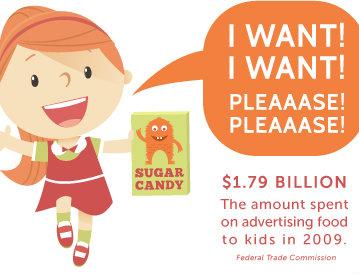
Hands up if you've made this face at the grocery store. Or let's be honest: in almost ANY check-out line with your kids. I can't even buy glue in a craft store without being forced to walk past an aisle of junk, placed at my kids' eye level, on my way to check out.
And at first glance, that’s where it seems to end. It’s annoying. Parents think that we should just do our job and say no. Put our foot down, and teach our kids good behaviors.
Me pushing back on the marketing targeting my kid. At least I'm getting some cardio in?
But as parents we DO have the power to tell companies to stop. Check out these these terrifying facts about junk food marketing to kids.
Vending machine labeling (although they now can’t sell “regular” soda, then can still feature images of it on the machine itself); Scoreboards and other school signage; Benefit nights at restaurants; Donated classroom materials, such as math or reading worksheets; Book covers; company-sponsored “Bucks for Books” programs; Box Tops for Education / Labels for Education; Fundraiser sale items: cookie dough, pizza, etc.; Branded disposable cups in cafeterias or sports; Special event signage (banners); Athletic uniforms or special event t-shirts; Channel One TV; “Good Job” stickers with corporate logos; Food coupons as discretionary awards from staff. (1)
I can NOT do this. Seriously. I've tried. Other things I cannot do: predict and stop the sneaky ads my kid gets through his phone, in video games and commercials, etc.
When these ads target young people, they reach them at a time when their identity is susceptible to outside influences, including powerful media imagery. This period of upheaval during adolescence is especially important when it comes to marketing messages, as youth from communities of color often use consumption as a means to counteract experiences of social and economic marginalization. This means that target marketing presents a serious challenge to youth: not only do marketers promote unhealthy foods, but they also exploit symbols of cultural relevance, even affecting young people's developing identities to do so. (3)
Let me get this straight: companies actually play on the insecurities of my kids to sell them junk? Not ok.
"Advertisers use cues such as asethnic symbols, linguistic styles, and music to link cultural values, beliefs and norms with the consumption of specific food products." (6)
Things are legit getting scary.
- One in three children in the US is overweight or obese. (8)
- Obesity rates in the US have doubled since 1970. (9)
- Healthcare costs related to obesity exceed $100 billion annually. (10)
- Twenty-seven percent of young people are too overweight to serve in the military. (11)
If Morgan's concerned, you know we're in trouble.
- This spring, both Wendy's and Burger King removed soda as a default beverage in kids' meals, after being pressured from tens of thousands of moms.
- Moms submitted thousands of comments in support of limiting junk food marketing in schools, through the updates to the Local School Wellness Policies last year.
And our work continues, as we call on both Nickelodeon and the food and beverage industry more broadly to limit junk food marketing to our kids.
We need all hands on deck. Moms: we need to keep it up. Join us in demanding companies stop trying to undermine the good practices we're working so hard to teach our kids. Join us for the long haul by signing up for the Good Food Force! You'll get special updates, invitations to online events, and have the chance to connect with other food activists making a difference at the local level. Because, moms ...









The views and opinions expressed in this post are those of the author(s) and do not necessarily reflect those of MomsRising.org.
MomsRising.org strongly encourages our readers to post comments in response to blog posts. We value diversity of opinions and perspectives. Our goals for this space are to be educational, thought-provoking, and respectful. So we actively moderate comments and we reserve the right to edit or remove comments that undermine these goals. Thanks!